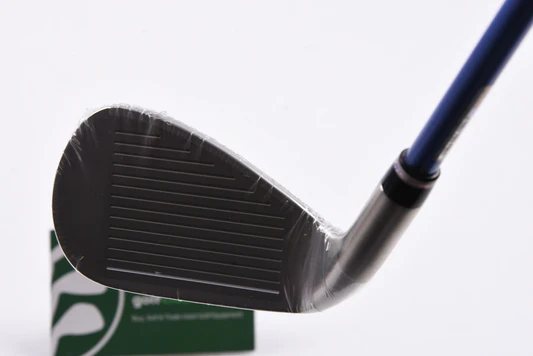Bogey… par… albatross…. It's one thing getting started in golf, learning how to perfect your swing and understanding the handicap system, but it’s quite another getting your head around the many golfing terms that players use as a shortcut when they speak.
While golf jargon, acronyms and terminology can be helpful when you know what you’re talking about, to a beginner they can be quite confusing - even to the point where you’re nervous to play because you don’t know the lingo and don’t want to embarrass yourself.
At golfclubs4cash we’re all about removing barriers for anyone wanting to get into golf, so we’ve put together this helpful guide to the most common golfing terms that you are likely to hear on and off the course.
Kicking off our golfing jargon buster, we’re going to focus on the most commonly used golfing jargon and acronyms you’re likely to come across. Later on in this article, we’ll look at the different types of clubs and what they all do. Is there anything you’d like to know that’s not on the list? Get in touch and one of our friendly pros will help explain it to you.


The complete guide to commonly used golfing terminology and jargon
Why is golf called golf?
Let’s start with the absolute basics. Nobody is entirely sure of the origins of the word ‘golf’, but one of the most commonly believed answers is that it comes from the Scottish word ‘goulf’ - meaning to strike. That sounds entirely plausible to us, so we’ll go with that! (There is an urban myth that constantly floats around which suggests that ‘golf’ might be an acronym for ‘Gentlemen Only, Ladies Forbidden’, but this is entirely incorrect and it’s high time that myth was buried for good).
Looking for a new Iron Set under £250? Browse our latest stock below.


Ping G5 Irons / 4-PW+SW / Black Dot / Regular Flex Ping TFC 100 Shafts


Nike Ignite 3 Irons / 4-PW+SW / Uniflex ignite Shafts


Callaway Big Bertha 2002 Irons / 5-PW+GW / Regular Flex Callaway RCH 75 Shafts


Mizuno JPX 825 Irons / 5-PW / Regular Light Flex Fujikura Orochi 60 Shafts


Ladies Callaway Big Bertha 1996 Irons / 4-PW+SW / Ladies Flex Callaway Gems


Ping Karsten 2014 Irons / 5-PW+UW / Black Dot / Senior Flex Ping KS 401 Shafts


Callaway Big Bertha 2015 Irons / 5-9i / Senior Flex UST Recoil 460 Shafts


Orka RS-10 MB Irons / 5-PW / Regular Flex Kuro Kage Silver 70IR Shafts
Golf scoring terminology
What does ‘playing off scratch’ mean?
‘Playing off scratch’ is what a ‘scratch player’ does. And what’s a scratch player? It’s someone who plays off a handicap of 0. That means that they are more likely than not to complete a round of golf in the expected number of shots. So, if they were playing a par-70 course, it’d take them 70- shots to complete. You can read more about scratch players in our article about the golfing handicapping system.

That’s all very well, but what’s par?!
Each golf course has its own difficulty rating, with some being easier to play than others. So they are each given a ‘par rating’, which means how many shots a scratch golfer would be expected to make to complete the course. An 18-hole course would typically be around 72-par, with most of the holes having an individual par rating of 3, 4, or 5 - which means it would take that many shots for a scratch golfer to get from the tee to the hole.
Yes but what’s a tee?!
A tee is a thin wood or plastic peg that raises the golf ball off the ground for the first shot you play (from the ‘tee box’). The time you ‘tee off’ - the time you’ve booked your round to start - is sometimes called your ‘tee time’.
What’s a slope and course rating?
You’ll find a detailed explanation of slope ratings, course ratings, and their relation to par in our article all about handicaps. In the simplest of terms, they’re both about the difficulty of a course and how the par is calculated.
What’s a birdie? And what’s a bogey? And an albatross?
These are two of the stranger golfing terms that are commonly used, so let’s look at what they mean. They both refer to scoring (just like par), so it’s good to understand par first, then these terms will make more sense.
A ‘birdie’ is when you play a shot and come in one shot under par. So on a par-4 hole, you’d complete it in 3 shots. If you came in one over par on the same par-4 hole, taking 5 shots, you’d have got yourself a bogey. So in basic terms, birdie = good, bogey = not so good! A double bogey (two over par) is also called a buzzard, and a double birdie, aka an eagle, is two under par. An ‘albatross’ shot means three fewer shots than par. Pretty rare, for sure.

Other scoring terminology

You might hear a player say that they are ‘even par’ for their round. That means they’ve got off to a good start by completing the first couple of holes ‘on par’ - that is to say they’ve completed the hole in the expected number of shots. If they’re ‘two under’, that means they’ve already bagged themselves two birdies, and if they’re ‘two over’ then they’ve played two bogeys.
Of course, we can’t finish our section on scoring without giving a nod to the much-yearned-for hole-in-one. As the name would suggest, a hole-in-one is a perfect shot that comes off the tee and straight into the hole. As you can imagine, this isn’t a common event, and many golfers never manage to achieve it. You might also hear it being called an ‘ace’. Whatever it’s called, it’s an amazing feeling and if you’re lucky enough to experience it you’ll never forget that moment!
Golf terminology on the course
What are links, fairways, roughs and greens in golf?
Golf links are a certain type of golf course with features such as sand bunkers and a lot of firm, mown grass. You won’t often see hazards such as trees or water features on a links course, and this type of golf course is usually found close to the sea because of the challenging and often strong winds. One of the most famous links courses is the Old Course at St Andrews. The big golfing championships are always played on a links course.
As for fairways and greens, a fairway is a closely mown area between the tee and the putting green. The rough, as the name would suggest, features longer grass and it borders the fairway. The green is maintained by greenkeepers to keep the grass very short. It’s where the hole is and where your short shots happen - your putts.
What are drives, putts, pitches and approach shots?
There are many different types of golfing shots that can be taken, depending on where on the course you are, what the course is like and what your plan is! Here are some of the most common ones.
Drives happen off the tee, using a driver. These are the long shots that get you (hopefully!) as close to the hole as possible. Golfers agonise over which driver to take out with them on the course, and you can find out more about drivers in our comprehensive buying guide.
A pitch is a shorter shot where you need to gain some height, for example, if you need to get out of a bunker or over a tree. You use a high-lofted club for this called a pitching wedge (and find out more about loft and lie in our recent article).
What about putting? A putt is your short precision shot on the green, where you use a putter to get your ball into the hole. Generally, the ball will stay on the ground for this shot. Check out our article on buying a second hand putter to help you decide which putters are the best match for you.
An approach shot is a shot played after your drive, but still using a full golfing swing (as opposed to a gentler putt or pitch). It’s good golf etiquette to keep up a sensible pace around the course, but if you’re playing slowly, it’s best to let players ‘play through’ - that means stepping aside to let them play the hole before continuing with your game.
While we’re talking golf about different shots, a ‘point of address’ is the way in which you stand as you prepare to take your shot.

Parts of a golf club
Each type of club has similarities and differences, but they all have a club head, with a club face (the side that hits the ball). The ‘sweet spot’ of the clubface is at the centre of the club face and if you strike the ball perfectly here you’ll get a nice shot. The long handle is called the golf shaft, and it has a grip at the top. You may also hear people talking about the club ‘sole’ - the bottom of the clubface - find out more about this in our article explaining loft and lie. The heel is the past of the clubhead closest to the shaft and the hosel is the part that connects with the shaft. And the toe is the part of the clubhead that’s furthest away from the shaft.
When things go wrong
The ‘yips’ is every golfer’s enemy and is when you either have a mental block or a muscle spasm that stops you from doing a decent job of the simplest shots on the course. It tends to kick in on the putting greens, with jerky motions and overthinking taking over. There's not much you can do when the yips set in, other than put it down to experience and hope for an easier time on your next round.
A shank shot is one of those embarrassing moments when it all goes wrong and you mess up your shot completely. It usually happens when you hit the ball off the neck, toe or heel of your golf club. There isn’t a player out there who doesn’t fall victim to the occasional shank shot, so the best thing to do is laugh it off, move on and try to forget it ever happened!
Sometimes on a shot, the ball heads off in a curved direction according to whether you’re left or right-handed. This is called a slice, and it’s usually down to a misaligned swing that’s outside-in. You may also hear this referred to as a banana ball for obvious reasons!
A fat shot is where the club has dug into the ground before making contact with the ball, leading to a slower, shorter shot. A thin shot, also called a blade shot, is where your clubface has made contact with the ball a little too high (so the opposite of a fat shot), resulting in a low shot that lacks power. An extreme version of the thin shot is the top shot which is where the clubhead barely makes any contact with the top of the ball at all.
A whiff shot is very bad news indeed and leaves golfers looking very red in the face! It’s when you’ve gone for a shot, and missed the ball completely, and it’s called a ‘whiff’ because of the noise that’s created by not hitting the ball at all. The even worse news is that official golf rules say that this must still be counted as a shot, even though you’ve not even touched the ball.
Other golf jargon explained
Another common term you might hear on or off the golf course might include ‘fore!’. If you hear someone shout this, then it’s probably best to duck or get out of the way, because it means that a ball is flying very close to someone. If you hit a shot that doesn’t go in the direction you expect, and you see it heading towards another player, then it’s good golfing etiquette to shout it as loud as you can so they have enough warning to be able to get out of the way in time. But to avoid this situation it’s always best to make sure everyone is out of the way before you take your shot.
You might hear people talking about the 19th hole. Don’t panic, it’s not a certain type of golf course with an extra challenging hole at the end, but rather a colloquial term for the bar! There’s nothing better than a cold refreshing drink after a long round of golf, and so golfers arrange to meet in the 19th hole for a chat and a debrief on their game. Of course, if you’re playing a 9-hole golf course, of which there are many, the bar could more accurately be called the 10th hole.

Golf equipment - types of clubs and accessories
Once you’ve swotted up on your golfing terminology, it’s a good idea to study the different types of clubs, and understand what type of shot each one is used for. The main golf clubs are drivers, fairway woods, hybrids/utilities, irons, wedges, and putters, and we’ve written a dedicated and comprehensive second hand golf equipment buying guide for each of the different types of clubs to help you decide on which one is best for you, along with a guide to buying used golf bags, and other golfing accessories such as golf GPS and rangefinder devices.
There’s more about choosing the right golf clubs for you in our article which tells you the three most important golf clubs to have in your bag.


Ladies Cleveland Launcher XL Halo #5 Wood / 18 Degree / Ladies Flex Cypher 55


Cobra Air-X Offset #5 Wood / 20 Degree / Regular Flex Cobra UltraLite 50 Shaft


Mizuno Pro 245 irons / 4-PW / Regular Flex Dynamic Gold Mid 100 R300 Shafts


XXIO X Black #3 Hybrid / 18 Degree / Stiff Flex Miyazaki AX-1 Shaft


Ladies Cleveland Launcher XL Halo #5 Iron / 23 Degree / Ladies Flex Cypher 40


Ladies XXIO 11 #6 Iron / 27 Degree / Ladies Flex XXIO MP 1100 Shaft


Cobra King 3D Printed Agera AL Putter / 41 Inch


Cobra Air-X Driver / 11.5 Degree / Senior Flex Cobra UltraLite 40 Shaft
DON’T WAIT TO ‘KNOW IT ALL’ BEFORE YOU GET OUT ON THE COURSE
In any walk of life, there are always plenty of words and phrases that you don’t know the meaning of. The good news is that golfers tend to be a friendly bunch, so if there’s something that you don’t know and that you need explaining to you, just ask - they’ll usually be happy to help.
It may feel a bit overwhelming to start with, but don’t let the fact that you haven’t got your ‘golf talk’ down to a tee just yet (see what we did there…). By simply getting out there and playing a few friendly rounds of golf, you’ll be able to build on your golfing vocabulary and gain a deeper understanding of the game and how it’s played and scored.
At golfclubs4cash we’re Europe’s biggest supplier of second hand golf equipment, and we’re here to demystify golf for you and give you the knowledge and equipment you need to get out on the course. If you’ve got any golfing questions - whether it’s a question about what second hand golfing equipment is best for you, or about golfing terminology that’s leaving you baffled, our friendly team of golfing pros are here to help. Pop into one of our golf stores in Edinburgh or Warrington, or give us a call if you live a little further afield.


















































